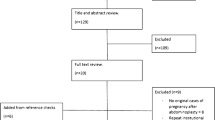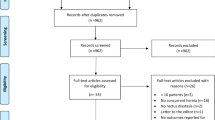Abstract
Introduction
This review aims to describe the surgical options available for treatment of diastasis recti in postpartum women, as well as compare the effectiveness of these treatment options. Historically, diastasis recti has been repaired through open procedures, such as abdominoplasty. More recently, studies have explored other methods for the treatment of diastasis recti, including various minimally invasive surgical options.
Methods
Twelve studies ranging from 2015 to 2022 were included in this analysis. Studies were identified using PubMed, EMBASE, and Cochrane Library. Studies that met the inclusion criteria were analyzed descriptively. Statistical comparison of surgical outcomes between studies was performed using Fisher’s Exact Test in SPSS.
Results
Minimally invasive approaches were categorized as laparoscopic preaponeurotic approaches, robotic approaches, and enhanced-view/extended totally extraperitoneal (eTEP) approaches. These techniques were compared to two open approaches: abdominoplasty and miniabdominoplasty. There were no significant differences in the rate of seromas, surgical site infections/complications, or hematomas between abdominoplasty and minimally invasive surgical techniques (p > 0.05). Among the minimally invasive techniques, no significant differences in readmission rates were reported (p > 0.05). Additionally, no significant differences in recurrence rates were seen following minimally invasive or abdominoplasty repairs, except for the increased recurrence rates seen with the r-TARRD robotic technique (p < 0.05).
Conclusion
Although current data on minimally invasive approaches is limited, our review reveals that both open and minimally invasive approaches are viable options for diastasis recti repair in postpartum women. Identifying the optimal approach for diastasis recti repair should rely on the patient’s desired treatment outcome. If the patient indicates a desire for the removal of excess abdominal subcutaneous tissue, abdominoplasty may be a better surgical approach. Alternatively, if the patient puts a greater emphasis on shorter recovery time and smaller surgical incisions/scars, minimally invasive approaches may be a better surgical option.


Similar content being viewed by others
References
Janes LE, Fracol ME, Dumanian GA (2019) Appreciation of postpartum changes of the rectus muscles in primary and repeated abdominoplasty. Plast Reconstr Surg 144(2):197e–204e. https://doi.org/10.1097/prs.0000000000005862
Sperstad JB, Tennfjord MK, Hilde G, Ellström-Engh M, Bø K (2016) Diastasis recti abdominis during pregnancy and 12 months after childbirth: prevalence, risk factors and report of lumbopelvic pain. Br J Sports Med 50(17):1092–1096. https://doi.org/10.1136/bjsports-2016-096065
Baumann DP, Butler CE (2019) Diastasis recti and primary midline ventral hernia: the plastic surgery approach. Hernia 23(5):1017–1018. https://doi.org/10.1007/s10029-019-02055-y
Cuccurullo D, Guerriero L, Mazzoni G, Sagnelli C, Tartaglia E (2022) Robotic transabdominal retromuscular rectus diastasis (r-TARRD) repair: a new approach. Hernia. https://doi.org/10.1007/s10029-021-02547-w
Manetti G, Lolli MG, Belloni E, Nigri G (2021) A new minimally invasive technique for the repair of diastasis recti: a pilot study. Surg Endosc 35(7):4028–4034. https://doi.org/10.1007/s00464-021-08393-2
Bucaria V, Boccuzzi A (2021) Autologous dermal mesh in severe postpregnancy recti muscles diastasis. Aesthetic Plast Surg 45(1):198–211. https://doi.org/10.1007/s00266-020-01991-w
Taylor DA, Merten SL, Sandercoe GD et al (2018) Abdominoplasty improves low back pain and urinary incontinence. Plast Reconstr Surg 141(3):637–645. https://doi.org/10.1097/prs.0000000000004100
Emanuelsson P, Gunnarsson U, Dahlstrand U, Strigård K, Stark B (2016) Operative correction of abdominal rectus diastasis (ARD) reduces pain and improves abdominal wall muscle strength: a randomized, prospective trial comparing retromuscular mesh repair to double-row, self-retaining sutures. Surgery 160(5):1367–1375. https://doi.org/10.1016/j.surg.2016.05.035
Gama LJM, Barbosa MVJ, Czapkowski A, Ajzen S, Ferreira LM, Nahas FX (2017) Single-layer plication for repair of diastasis recti: the most rapid and efficient technique. Aesthet Surg J 37(6):698–705. https://doi.org/10.1093/asj/sjw263
Nahabedian MY (2021) Diastasis recti repair with onlay mesh. Hernia 25(4):855–862. https://doi.org/10.1007/s10029-021-02464-y
Bellido Luque J, Bellido Luque A, Valdivia J et al (2015) Totally endoscopic surgery on diastasis recti associated with midline hernias. The advantages of a minimally invasive approach. Prospective cohort study. Hernia 19(3):493–501. https://doi.org/10.1007/s10029-014-1300-2
Cuccomarino S, Bonomo LD, Aprà F, Toscano A, Jannaci A (2022) Preaponeurotic endoscopic repair (REPA) of diastasis recti: a single surgeon’s experience. Surg Endosc 36(2):1302–1309. https://doi.org/10.1007/s00464-021-08405-1
Juárez Muas DM (2019) Preaponeurotic endoscopic repair (REPA) of diastasis recti associated or not to midline hernias. Surg Endosc 33(6):1777–1782. https://doi.org/10.1007/s00464-018-6450-3
Fiori F, Ferrara F, Gobatti D, Gentile D, Stella M (2021) Surgical treatment of diastasis recti: the importance of an overall view of the problem. Hernia 25(4):871–882. https://doi.org/10.1007/s10029-020-02252-0
Quezada N, Grimoldi M, Besser N, Jacubovsky I, Achurra P, Crovari F (2022) Enhanced-view totally extraperitoneal (eTEP) approach for the treatment of abdominal wall hernias: mid-term results. Surg Endosc 36(1):632–639. https://doi.org/10.1007/s00464-021-08330-3
Taşdelen HA (2022) The extended-view totally extraperitoneal (eTEP) approach for incisional abdominal wall hernias: results from a single center. Surg Endosc 36(6):4614–4623. https://doi.org/10.1007/s00464-021-08995-w
Carrara A, Catarci M, Fabris L et al (2021) Prospective observational study of abdominal wall reconstruction with THT technique in primary midline defects with diastasis recti: clinical and functional outcomes in 110 consecutive patients. Surg Endosc 35(9):5104–5114. https://doi.org/10.1007/s00464-020-07997-4
Acknowledgements
We would like to thank Dr. Venkat Venkataraman and the Rowan-Virtua Research Department for their support of this project.
Author information
Authors and Affiliations
Corresponding author
Ethics declarations
Disclosures
Emily Forester has no conflicts of interest to disclose. Dr. Aziz Sadiq reports consulting fees and honoraria from Intuitive Surgical.
Registration and protocol
Systematic review was registered with Research Registry (UIN: reviewregistry1584). A review protocol was not prepared. No amendments were made to the registered study information.
Additional information
Publisher's Note
Springer Nature remains neutral with regard to jurisdictional claims in published maps and institutional affiliations.
Rights and permissions
Springer Nature or its licensor (e.g. a society or other partner) holds exclusive rights to this article under a publishing agreement with the author(s) or other rightsholder(s); author self-archiving of the accepted manuscript version of this article is solely governed by the terms of such publishing agreement and applicable law.
About this article
Cite this article
Forester, E., Sadiq, A. Comparative analysis of the efficacy and functionality of abdominoplasty versus minimally invasive techniques in the surgical treatment of diastasis rectus abdominis in postpartum women. Surg Endosc 37, 9052–9061 (2023). https://doi.org/10.1007/s00464-023-10540-w
Received:
Accepted:
Published:
Issue Date:
DOI: https://doi.org/10.1007/s00464-023-10540-w




